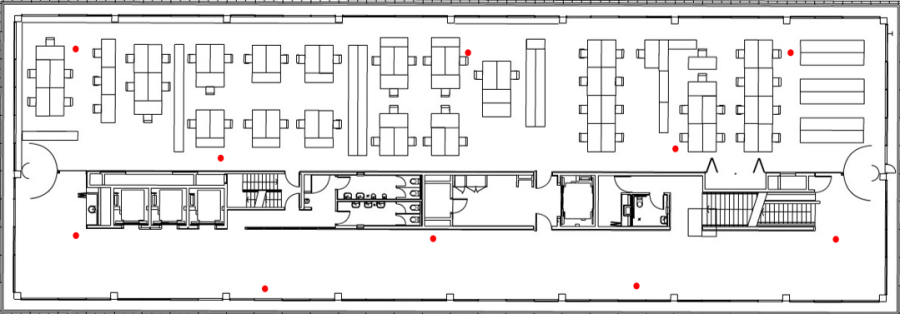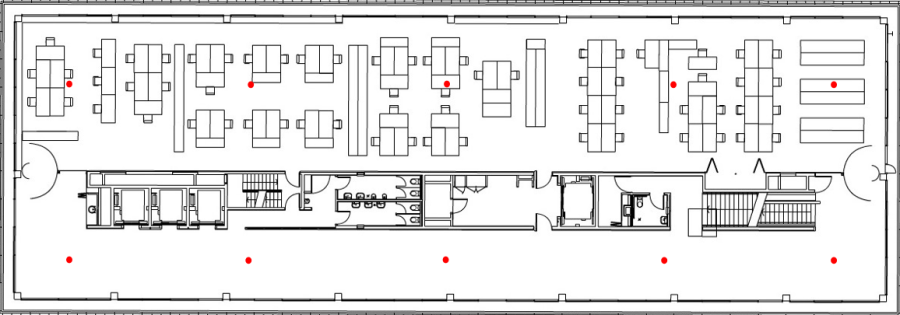SVLive Wi-Fi Overview
- Last updated
- Save as PDF
Overview
Wi-Fi Access Point Recommendations
To use the solution, the Serraview product requires that:
- Associated on-premise SVLive components are installed and operational.
- Access Points have unique BSSID's.
Additionally, the Serraview product requires the following information about each Access Point:
- Location (plotted on floorplan). Accurate locations will lead to accurate positioning of clients.
- BSSID.
- Height (from desk)
- Transmit Power.
The completeness and accuracy of the above information will greatly impact the precision at which the SVLive Wi-Fi Location Service can estimate the location of client devices.
To ensure reliable and accurate positioning, it is also strongly recommended that the following recommendations be observed where possible:
- Each potential device location should be able to detect at least 3, preferably 4, access points with signal strength stronger than -80dBm.
- Use Omnidirectional antennas in Access Points.
- Place Access Points with location services in mind, not just coverage.
- Use a fixed and consistent transmit power across Access Points.
- Avoid co-channel and adjacent-channel interference.
- Reduce obstacles to the line of sight (LOS) between devices and Access Points.
Wi-Fi Considerations
The following hardware, configuration, and environmental considerations should be understood and mitigated where possible to ensure consistent and accurate results.
Antennae Type
The antenna selection is an issue for positioning and must be well handled.
A low gain omnidirectional MIMO antenna is recommended for most of the indoor environments, which can reduce the client-based co-channel interferences and provides better quality signals.
An antenna gives the wireless system three fundamental properties: gain, direction and polarization. Antennas are various along with the shape of the signal transmission pattern, the characteristics of each type are explained below:
- Omnidirectional antenna is the best choice for multilateration based. It is suitable for relative open spaces such as open office areas, a conference rooms, warehouse and manufacturing floors.
- Dipole antenna is also a good choice. It has a perfect 360 degree vertical and horizontal beam width or a spherical radiation pattern, but it is a bit more theoretical and sometimes may cause multipath problem. It is good to be used in normal office areas, classrooms and other shared environments.
- Directional antenna (e.g. patch and yagi antennas) allows you to divert the RF energy in a particular direction to farther distances. This type of antenna is helpful in near LOS coverage, such as covering hallways, long corridors. However, as the angular coverage is less, it cannot cover large areas. It must be avoided to use directional antennas in large and wide areas with multilateration
Access Point Density
The number of access points connected to each end-user device is critical for location tracking. A good density of access points is both required by communications and positioning.
Theoretically a positioning and location tracking system requires higher density as the multi-lateration system requires 3 or more valid access points connected simultaneously.
Therefore, more access points would be desired if there is no co-channel and adjacent-channel interference problems produced.
In practice, the number of access points must satisfy both communication and location tracking.
For example, if:
- 20 active users per single access point is required by positioning, and
- 25-30 active users per single access point is required by communications,
then 20 active users per access point should be selected as the density determination rule. For places where concentrated set of concurrent users in a confined area (e.g. classroom, conference room), other factors should be also considered when designing the networks:
- Number of Wi-Fi devices per person (≥3, better ≥4)
- Coverage area per access point (may vary from 50 to 500 square meters)
- Percentage of users that are expected to be active (almost 100% for tracking but not for communications)
- Types of applications and throughput needed (less effect to tracking)
- Mix of applications (less effect to tracking)
- Type of clients in the network (e.g. 2.4 GHz vs. 5 GHz)
For Wi-Fi deployment within a specific enterprise or organization, there may be a mix of areas that require both coverage and high capacity.
For example, an office area may require full coverage of wireless signal whereas a canteen or conference room may require high capacity of Wi-Fi deployment. Both situations must be considered during the Wi-Fi deployment.
Access Point Mounting and Layout
Access point mounting and layout is important for positioning. It is recommended to mount access points in places where line of sight (LOS) or near-LOS conditions exist between each access point and the end-user device.
The following factors must be considered when dealing with access point mounting and layout:
- Straight-line placement. Avoid placing three or more access points along a straight line (refer to the diagrams below).
Layout for both communications and location tracking for a large office area

Layout for communications; not appropriate for location tracking

- LOS condition. Try to make an access point visible to end users, for example, mounting the access point on the ceiling with an up-down orientation.
- Signal transmission media. Ensure that signals from each access point are transmitted to the user's device through similar types of media.
- Height adjustment. Adjust the height of the access points to receive optimum signals.
- Floor isolation. Try to avoid users connecting an access point from different levels of the building. Potentially adjust the access point power level and/or use obstacles deliberately.
- Same height. Try to place all access points at the same height.
Access Point Transmit Power
Consistent transmit power levels are essential for reliable positioning via the SVLive Wireless Location Service.
The power configuration of the Wi-Fi system has a direct impact on the stability of the signal between device and access point, and the signal strength detected by tracked devices.
As much as possible, avoid;
- Setting different power levels manually for different access points, or
- Allowing transmit power to by automatically adjusted in response to changes in the RF environment.
Channel Interference
The rules for avoiding channel interference for communications (e.g. the 1-6-11 three channel choices for the 2.4 GHz Wi-Fi band) are also suitable for location tracking.
A site survey must be performed to determine the number of access points required, their optimal placement and the choice of channel to minimize interference.
Environment Factors
Indoor positioning and location tracking systems are environment-based applications. Surrounding environments are critical to a Wi-Fi based indoor positioning system.
In general, the following factors will impact accuracy:
- Physical objects - E.g. physical structures of the building, the number of walls the RF signal can pass through.
- Radio frequency interference - Devices in the same environment that share the same channel can cause noise and weaken the signals, as mentioned in early sections.
- Electrical interference - Coming from devices such as computers, refrigerators, fans, lighting fixtures, or any other motorized devices.
- Other environmental factors - E.g. lightning can cause electrical interference, and fog can weaken signals as they pass through.
Indoor RF propagation is not the same as it is outdoors. Indoor wireless signal propagation can be affected by reflection, refraction or diffraction in a particular environment due to the wireless obstacles (the multipath problem). It is possible to have plenty of wireless obstacles in a common indoor environment. These obstacles and their materials are more related to positioning systems and need to be well understood.
The table below highlights examples to be aware of during Wi-Fi deployment. Also, be aware that concrete and steel walls are particularly difficult for a signal to pass through. Other factors may also affect location tracking:
- Type of environment. Office, warehouse, single room hotel, lift. Environment types can help to decide on whether multilateration method will be the best choice for location tracking.
- Floor plan and ceiling height. Office (3 m), warehouse (6m), gymnasium (9m). Generally, the higher the ceiling height the better for location tracking when using multilateration. But this must be balanced with the communication requirements.
- Number of floors. For a multi-floor building, try to reduce wireless connections and interference from other floors.
- Exclusion areas. Locations where signal coverage is not needed/wanted for positioning purpose. Fortunately, this requirement is not in conflict with communication requirements.
Indoor Wireless Obstacle Severity
|
Obstruction |
Obstacle Severity |
Sample Use |
|---|---|---|
|
Wood/wood panels |
Low |
Inside a wall or hollow door |
|
Drywall |
Low |
Inside walls |
|
Furniture |
Low |
Couches or office partitions |
|
Clear glass |
Low |
Windows |
|
Tinted glass |
Medium |
Windows |
|
People |
Medium/high |
High-volume traffic areas that have considerable pedestrian traffic |
|
Ceramic tile |
Medium |
Walls |
|
Concrete blocks |
Medium/high |
Outer wall construction |
|
Mirrors |
High |
Mirror or reflective glass |
|
Metals |
High |
Metal office partitions, doors, metal office furniture |
|
Water |
High |
Aquariums, rain, fountains |
Understanding Wi-Fi Activity updates in Locator and Engage
When using Locator and Engage, you can expect Wi-Fi activity updates to typically reflect within a minimum of 2 minutes. However, note that this duration may vary due to various client-side network and hardware configurations.
Wi-Fi List of Abbreviations
|
Abbreviation |
Description |
|---|---|
|
AP |
access point |
|
BPSK |
binary phase-shift keying |
|
BSSID |
basic service set identifier |
|
DSSS |
direct sequence spread spectrum |
|
HD signal |
high definition signal |
|
ISM |
industrial scientific medical (radio band) |
|
LAN |
local area network |
|
LOI |
location of interest |
|
LOS |
line of sight |
|
MAC |
media access control |
|
MIMO |
multiple-input multiple-output |
|
OFDM |
orthogonal frequency division multiplexing |
|
PHY |
physical layer |
|
POE |
power over Ethernet |
|
QPSK |
quadrature phase-shift keying |
|
RF |
radio frequency |
|
Rx |
received power value |
|
SDM |
spatial division multiplexing |
|
SSID |
service set identifier |
|
WLAN |
wireless local area network |
